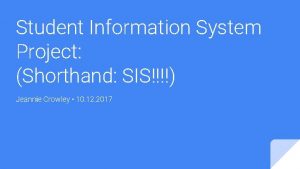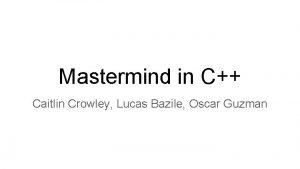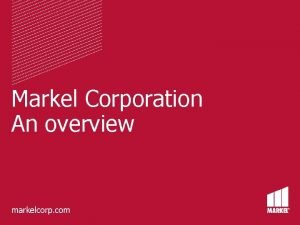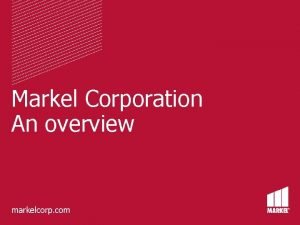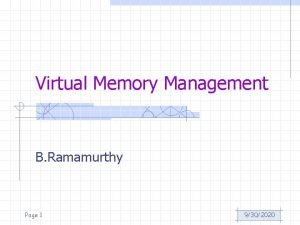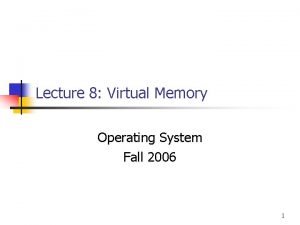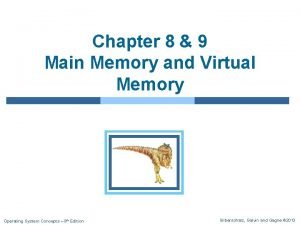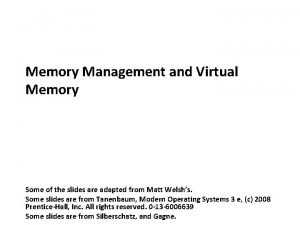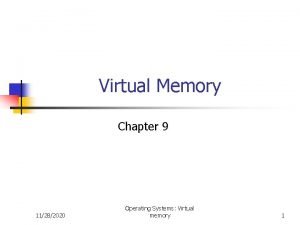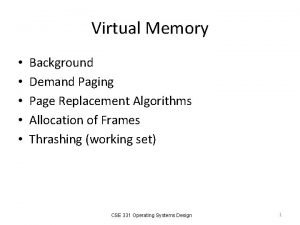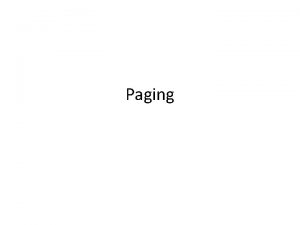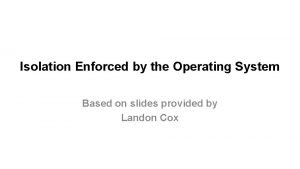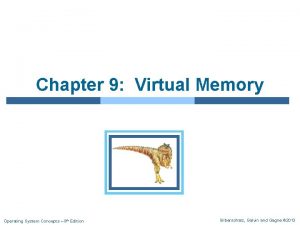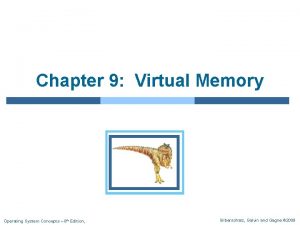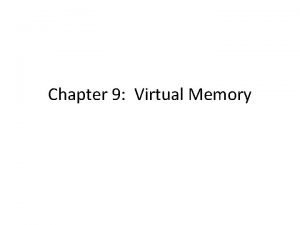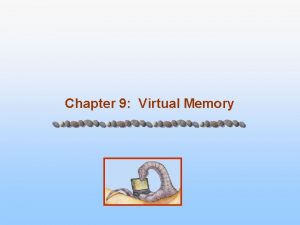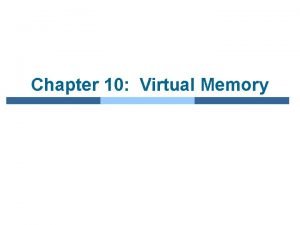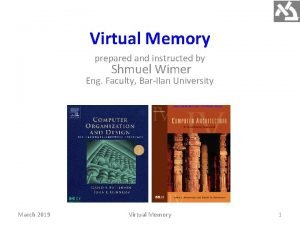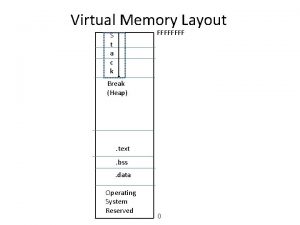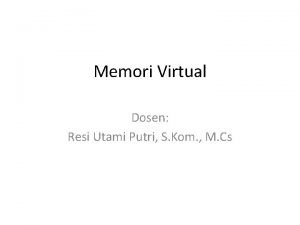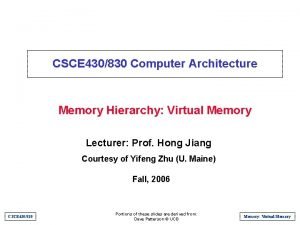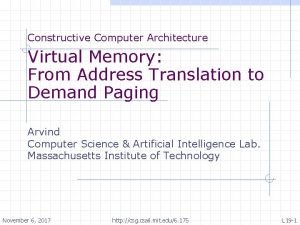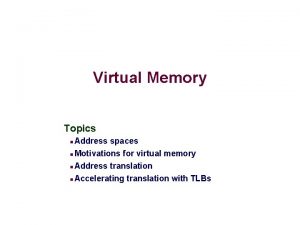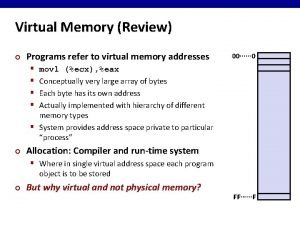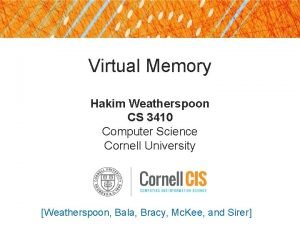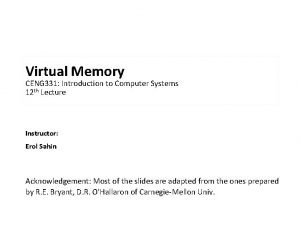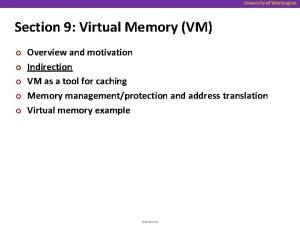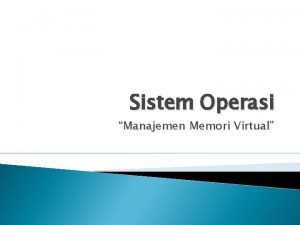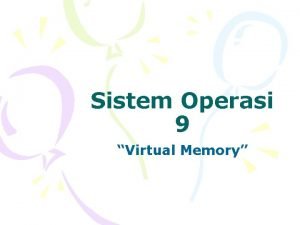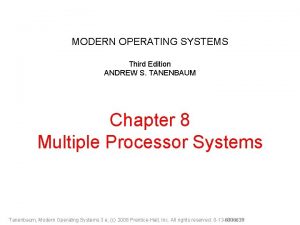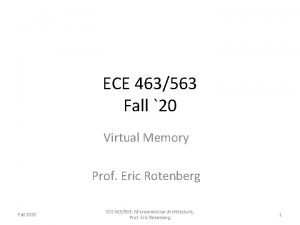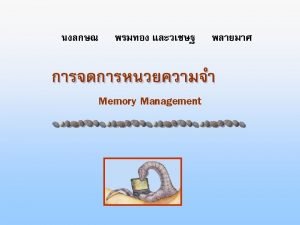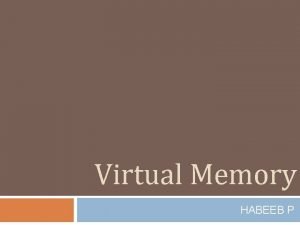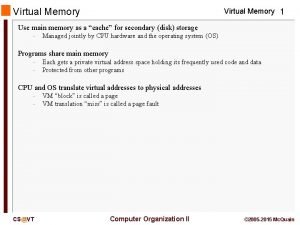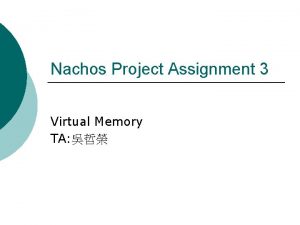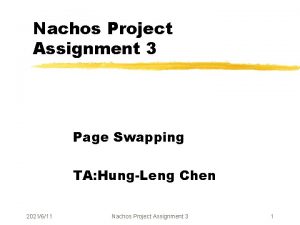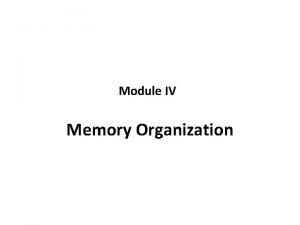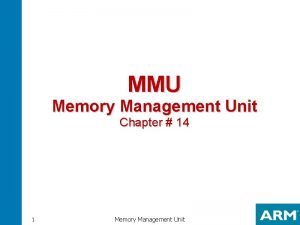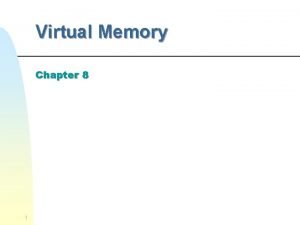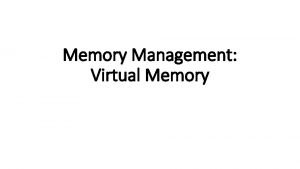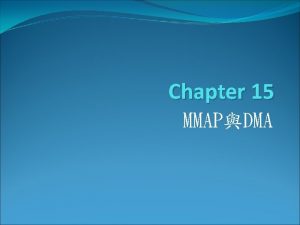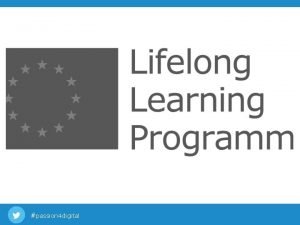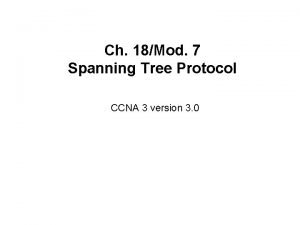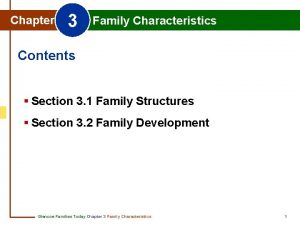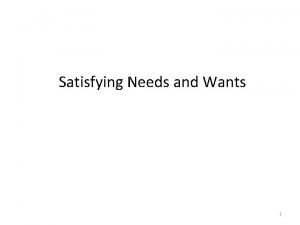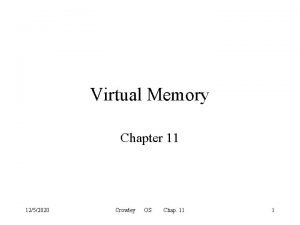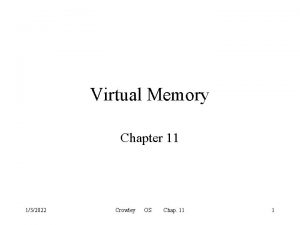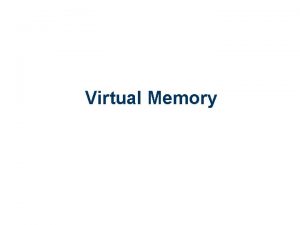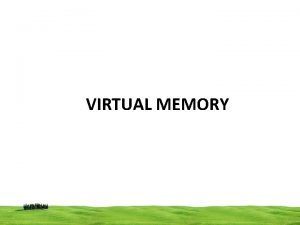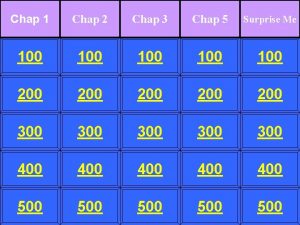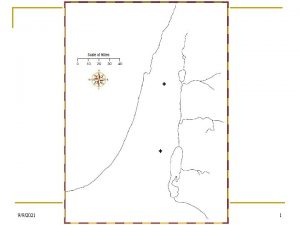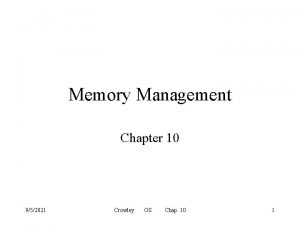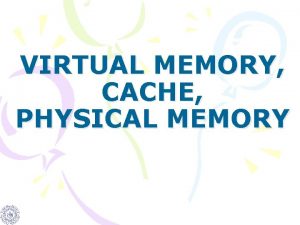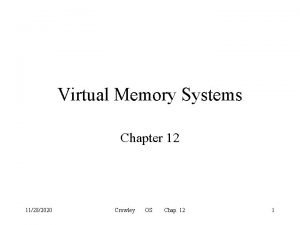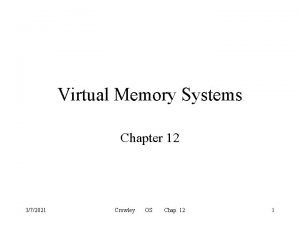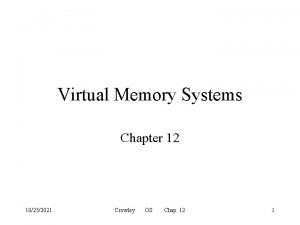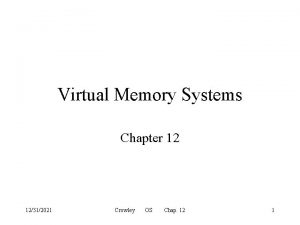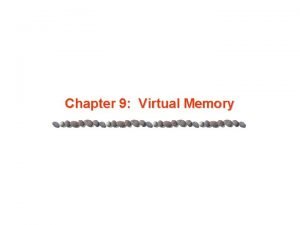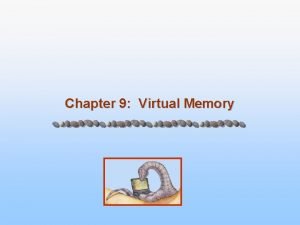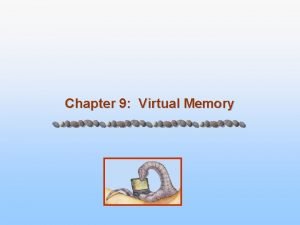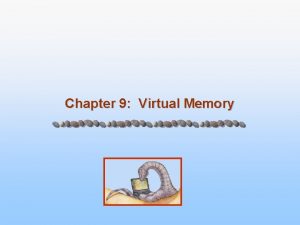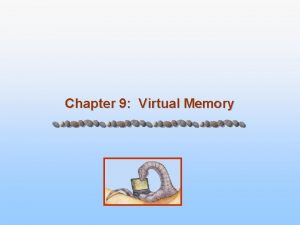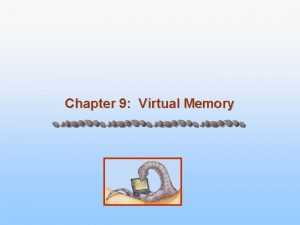Virtual Memory Chapter 11 992021 Crowley OS Chap







































































- Slides: 71

Virtual Memory Chapter 11 9/9/2021 Crowley OS Chap. 11 1

Key concepts in chapter 11 • • Fragmentation Virtual memory Paging File mapping 9/9/2021 Crowley OS Chap. 11 2

Compacting memory 9/9/2021 Crowley OS Chap. 11 3

Fragmentation • Without memory mapping, programs require physically continuous memory • Large blocks mean large fragments – and wasted memory • We need hardware memory mapping to address this problem – segments – pages • We will look at a series of potential solutions 9/9/2021 Crowley OS Chap. 11 4

Separate code and data spaces 9/9/2021 Crowley OS Chap. 11 5

Code/data memory relocation 9/9/2021 Crowley OS Chap. 11 6

Segmentation • Divide the logical address space into segments (variable-sized chunks of memory) • Each segment has a base and bound register – and so segments do not need to be contiguous in the physical address space – but the logical address space is still contiguous • DEC PDP 11 – eight segments – up to 8 K bytes per segment 9/9/2021 Crowley OS Chap. 11 7

Two segmented address spaces 9/9/2021 Crowley OS Chap. 11 8

Segmentation memory mapping 9/9/2021 Crowley OS Chap. 11 9

Contiguous 24 K logical address space 9/9/2021 Crowley OS Chap. 11 10

Noncontiguous 24 K logical address space 9/9/2021 Crowley OS Chap. 11 11

Noncontiguous logical address spaces • This is possible with segmentation hardware – but is not usually a good idea • Example segmentation map • Segment-Base - Limit - Logical address – 0 – 1 – 2 – 3 9/9/2021 100 K 194 K 132 K 240 K 6 K 6 K Crowley OS 0 K-6 K 16 K-22 K 32 K-38 K 48 K-54 K Chap. 11 12

Segments to pages • Large segments do not help the fragmentation problem – so we need small segments • Small segments are usually full – so we don’t need a length register – just make them all the same length • Identical length segments are called pages • We use page tables instead of segment tables – base register but no limit register 9/9/2021 Crowley OS Chap. 11 13

Hardware register page table 9/9/2021 Crowley OS Chap. 11 14

Problems with page tables in registers • Practical limit on the number of pages • Time to save and load page registers on context switches • Cost of hardware registers • Solution: put the page table in memory and have a single register that points to it 9/9/2021 Crowley OS Chap. 11 15

Page tables in memory 9/9/2021 Crowley OS Chap. 11 16

Page table mapping 9/9/2021 Crowley OS Chap. 11 17

Problems with page tables in memory • Every data memory access requires a corresponding page table memory access – the memory usage has doubled – and program speed is cut in half • Solution: caching page table entries – called a translation lookaside buffer – or TLB 9/9/2021 Crowley OS Chap. 11 18

TLB flow chart 9/9/2021 Crowley OS Chap. 11 19

TLB lookup 9/9/2021 Crowley OS Chap. 11 20

Caching the page table (1 of 2) • const int Page. Table. Cache. Size = 8; const int page. Size. Shift = 12; const int page. Size. Mask = 0 x. FFF; struct Cache. Entry { int logical. Page. Address; int page. Base. Address; } Page. Table. Cache[Page. Table. Cache. Size]; extern int page. Table. Base. Register; int Least. Recently. Used. Cache. Slot( void ); 9/9/2021 Crowley OS Chap. 11 21

Caching the page table (2 of 2) • int Logical. To. Physical( int logical. Address ) { int logical. Page. Address = logical. Address & ~page. Size. Mask; for( int i = 0; i < Page. Table. Cache. Size; ++i ) { // the hardware lookup is done in parallel if( Page. Table. Cache[i]. logical. Page. Address == logical. Page. Address ) return Page. Table. Cache[i]. page. Base. Address; } int pte. Address = page. Table. Base. Register + (logical. Address >> page. Size. Shift); int page. Base. Address = Memory. Fetch( pte. Address ); // now update the cache by replacing the entry that has // not been used in the longest time (the least recently // used one) with this new entry i = Least. Recently. Used. Cache. Slot(); Page. Table. Cache[i]. logical. Page. Addres=logical. Page. Address; Page. Table. Cache[i]. page. Base. Address = page. Base. Address; return page. Base. Address; } 9/9/2021 Crowley OS Chap. 11 22

Why TLBs work • Memory access is not random, that is, not all locations in the address space are equally likely to be referenced • References are localized because – sequential code execution – loops in code – groups of data accessed together – data is accessed many times • This property is called locality • TLB hit rates are 90+%. 9/9/2021 Crowley OS Chap. 11 23

Good and bad cases for paging 9/9/2021 Crowley OS Chap. 11 24

Internal and external fragmentation 9/9/2021 Crowley OS Chap. 11 25

Page and page frame • Page – the information in the page frame – can be stored in memory (in a page frame) – can be stored on disk – multiple copies are possible • Page frame – the physical memory that holds a page – a resource to be allocated 9/9/2021 Crowley OS Chap. 11 26

Page table entry 9/9/2021 Crowley OS Chap. 11 27

Page table protection • Three bits control: read, write, execute • Possible protection modes: – 000: page cannot be accessed at all – 001: page is read only – 010: page is write only – 100: page is execute only – 011: page can be read or written – 101: page can be read as data or executed – 110: write or execute, unlikely to be used – 111: any access is allowed 9/9/2021 Crowley OS Chap. 11 28

Paged memory allocator (1 of 4) • const int Page. Size = 4096; struct Memory. Request { int npages; // size of the request in pages Semaphore satisfied; // signal when memory allocated int * page. Table. Array; // store page numbers here Memory. Request *next, *prev; // doubly linked list }; // The memory request list // keep a front and back pointer for queue discipline Memory. Request * Request. List. Front, *Request. List. Back; // The structure for the free page list struct Free. Page { int page. Number; Free. Page *next; }; // The free page list Free. Page * Free. Page. List; int Number. Of. Free. Pages; 9/9/2021 Crowley OS Chap. 11 29

Paged memory allocator (2 of 4) • void Initialize( int npages ) { Request. List. Front = 0; Free. Page. List = 0; Number. Of. Free. Pages = npages; for( int i = 0; i < Number. Of. Free. Pages; ++i ) { Free. Page. List = new Free. Page( i, Free. Page. List ); } } // request procedure: request a piece to be allocated void Request. Block( int npages, Semaphore * satisfied, int * page. Table. Array ) { Memory. Request * n = new Memory. Request( npages, satisfied, page. Table. Array, 0 , 0); if( Request. List. Front == 0 ) { // list was empty Request. List. Front = Request. List. Back = n; } else { Request. List. Back->next = n; Request. List. Back = n; } Try. Allocating(); } 9/9/2021 Crowley OS Chap. 11 30

Paged memory allocator (3 of 4) • void Try. Allocating( void ) { Memory. Request * request = Request. List. Front; while( request != 0 ) { if( Can. Allocate( request ) { if( Request. List. Front == Request. List. Back ) { Request. List. Front = 0; request = 0; // drop out of loop } else { request->prev->next = request->next; request->next->prev = request->prev; Memory. Request * oldreq = request; // save the address request = request->next; delete oldreq; } } else request = request->next; } } 9/9/2021 Crowley OS Chap. 11 31

Paged memory allocator (4 of 4) • void Free. Pages( int npages, int page. Table[] ) { for( int i = 0; i < npages; ++i ) Free. Page. List = new Free. Page( page. Table[i], Free. Page. List ); } int Can. Allocate( Memory. Request * request ) { if( request->npages >= Number. Of. Free. Pages ) { Number. Of. Free. Pages -= request->npages; int * p = request->page. Table. Array; for( int i = 0; i < request->npages; ++i ) { *p++ = Free. Page. List->page. Number; Free. Page * fpl = Free. Page. List; Free. Page. List = Free. Page. List->next; delete fpl; } return True; } return False; } 9/9/2021 Crowley OS Chap. 11 32

The design process • Evolution of solutions to the memory problem is a good example of the design process in action – at each stage the current solution had a problem – we modified the design to fix the problem – this created a new problem – we continued until the solution was good enough • Sometimes we reused previously discarded ideas 9/9/2021 Crowley OS Chap. 11 33

Time and space multiplexing • The processor is a time resource – It can only be time multiplexed • Memory is a space resource – We have looked at space multiplexing of memory – Now we will look at time multiplexing of memory 9/9/2021 Crowley OS Chap. 11 34

Time and space multiplexing of hotel rooms 9/9/2021 Crowley OS Chap. 11 35

Time multiplexing memory • Swapping: move whole programs in and out of memory (to disk or tape) – allowed time-sharing in early Oss • Overlays: move parts of program in and out of memory (to disk or tape) – allowed the running of programs that were larger than the physical memory available – widely used in early PC systems 9/9/2021 Crowley OS Chap. 11 36

Swapping 9/9/2021 Crowley OS Chap. 11 37

Design technique: Persistent objects • A process was a dynamic entity in the system – we wanted to write it out to disk – and read it back in again later – kind of freeze and unfreeze it • The ability to write an object to disk is called persistence, and it very useful • It allows objects to live beyond the execution of the program that creates them 9/9/2021 Crowley OS Chap. 11 38

How to create persistence • Basically simple – write out a representation of the objects • Problems – pointers and references: we must encode these in some way in order to write them out – following references: we also have to write out everything the object refers to. 9/9/2021 Crowley OS Chap. 11 39

Design stages: Design and implementation • • First we decide what we want Then we decide how to implement it Each stage requires design Feedback is often required in order to avoid inefficient designs • In operating systems – we often useful services to the processes – and try to implement them efficiently 9/9/2021 Crowley OS Chap. 11 40

Overlays 9/9/2021 Crowley OS Chap. 11 41

Overlays in PCs 9/9/2021 Crowley OS Chap. 11 42

Virtual memory 9/9/2021 Crowley OS Chap. 11 43

Implementation of virtual memory • Virtual memory allows – time multiplexing of memory – users to see a larger (virtual) address space than the physical address space – the operating system to split up a process in physical memory • Implementation requires extensive hardware assistance and a lot of OS code and time – but it is worth it 9/9/2021 Crowley OS Chap. 11 44

Virtual memory algorithm (1 of 2) • const int Logical. Pages = 1024; const int Byter. Page = 4096; const int Offset. Shift = 12; const int Offset. Mask = 0 x. FFF; const int Physical. Pages = 512; enum Access. Type { invalid = 0, read = 1, write = 2, execute = 3 }; struct Page. Table. Entry { int page. Base : 9; int present : 1; Access. Type protection : 2; int fill : 4; // fill to 16 bits }; Page. Table. Entry User. Page. Table[Logical. Pages]; 9/9/2021 Crowley OS Chap. 11 45

Virtual memory algorithm (2 of 2) • int Memory. Access( int logical. Address, Access. Type how, int data. To. Write = 0 ) { int page = logical. Address >> Offset. Shift; int offset = logical. Address & Offset. Mask; Page. Table. Entry pte = User. Page. Table[page]; if( how != pte. protection ) if( !(how = read && ptr. protection = write) ) { Cause. Interrupt( Protection. Violation ); return 0; } if( pte. present == 0 ) { Generate. Interrupt( Page. Fault, page ); return 0; } int physical. Address = (pte. page. Base << Offset. Shift) + offset; switch( how ) { case read: case execute: return Physical. Memory. Fetch(physical. Address); case write: Physical. Memory. Store( physical. Address, data. To. Write ); return 0; } } 9/9/2021 Crowley OS Chap. 11 46

Virtual memory software • The virtual memory (a. k. a. paging) system in the OS must respond to four events – process creation – process exit – process dispatch – page fault 9/9/2021 Crowley OS Chap. 11 47

Virtual memory events 9/9/2021 Crowley OS Chap. 11 48

Process creation actions • 1. Compute program size (say N pages) • 2. Allocate N page frames of swap space • 3. Allocate a page table (in the OSs memory) for N page table entries. • 4. Initialize the swap area • 5. Initialize the page table: all pages are marked as not present. • 6. Record the location in the swap area and of the page table in the process descriptor 9/9/2021 Crowley OS Chap. 11 49

Process exit actions • 1. Free the memory used by the page table • 2. Free the disk space in the swap area • 3. Free the page frames in process was using 9/9/2021 Crowley OS Chap. 11 50

Process dispatch actions • 1. Invalidate the TLB (since we are changing address spaces) • 2. Load the hardware page table base register with the address of the page table for this process 9/9/2021 Crowley OS Chap. 11 51

Page fault actions • 1. Find the faulting page (say page K) • 2. Find an empty page frame. This will involve replacing a page. • 3. Read in page K to this page frame • 4. Fix up the page table entry for page K. Mark it present and set the base address. • 5. Restart the process with the instruction that caused the page fault 9/9/2021 Crowley OS Chap. 11 52

Locality • Programs do not access their address space uniformly – they access the same location over and over • Spatial locality: processes tend to access location near to location they just accessed – because of sequential program execution – because data for a function is grouped together • Temporal locality: processes tend to access data over and over again – because of program loops – because data is processed over and over again 9/9/2021 Crowley OS Chap. 11 53

Design technique: Locality • Locality is almost always present – and often we can optimize a design by taking advantage of it. • Caching is a common name for systems that take advantage of locality to optimize operations 9/9/2021 Crowley OS Chap. 11 54

Practicality of paging • Paging only works because of locality – at any one point in time programs don’t need most of their pages • Page fault rates must be very, very low for paging to be practical – like one page fault per 100, 000 or more memory references 9/9/2021 Crowley OS Chap. 11 55

VM data structures 9/9/2021 Crowley OS Chap. 11 56

VM events and procedures 9/9/2021 Crowley OS Chap. 11 57

Daemons and events • OS usually respond to events – but sometime they need to be proactive • An OS daemon is a process that wakes up every so often and looks to see if it has any work to do • It is useful to keep a pool of free pages – so page faults can be handled immediately • A paging daemon wakes up every so often and keeps the free page pool large enough 9/9/2021 Crowley OS Chap. 11 58

Design technique: System models and daemons • Operating systems are essentially reactive – they react to interrupts • But if we include timer interrupts – then operating systems are sort of doing things on their own, that is, being proactive • This is what we call a daemon – a daemon wakes up and checks to see if something needs doing 9/9/2021 Crowley OS Chap. 11 59

Reactive and proactive user interfaces • Graphical user interfaces are generally reactive, they wait for user actions – this is a good model and puts the user in control which is good psychologically • Agents are a new user interface concept – agents are proactive – they go out and look for useful things to do 9/9/2021 Crowley OS Chap. 11 60

Design technique: Polling, software interrupts and hooks • How can a process know when an event occurs? There are two approaches • polling: it can check periodically • interrupts: it can ask another process to interrupt it when the event occurs – the other process is usually the one that causes or handles the event – so it is not much trouble for it to inform the waiting process that the event has ocurred. 9/9/2021 Crowley OS Chap. 11 61

Polling versus interrupts • Daemons use polling to discover events – and then react to the event • Polling is easier to set up but is less efficient than being interrupted – but interrupts require a process to do the interrupting – there might be no such process – or it might not be set up to provide interrupts 9/9/2021 Crowley OS Chap. 11 62

Hooks • A hook is the ability to register a procedure to be called when an event occurs • Systems that provide hooks are easy to modify – emacs provides hooks for many editing events – widget callback functions are hooks – a hook is basically a software interrupt 9/9/2021 Crowley OS Chap. 11 63

File mapping • File mapping is the mapping of a file on disk into the virtual address space of a process. • File I/O then consists of reading and writing words in the virtual address space – no system calls are required for read and write • This is also called a memory-mapped file. • The I/O system and the paging system both move data between disk and memory – so it makes sense to combine them 9/9/2021 Crowley OS Chap. 11 64

File mapping 9/9/2021 Crowley OS Chap. 11 65

File mapping system calls • A system call is required to map the file into the address space (and one to remove it). • char * Map. File( int open. File. Id, // file already open char * start. Address = 0, // 0: OS does it int start. Offset = 0, // into the file int length = 0 ); // 0: whole file • This call allows you to map a file in pieces – to save virtual address space 9/9/2021 Crowley OS Chap. 11 66

The Map. File system call 9/9/2021 Crowley OS Chap. 11 67

File mapping example code • int Count. Letter( char *file. Name, char letter) { int fid = open(file. Name, Reading); char * file. Area = Map. File(fid); int file. Length = Get. File. Length(fid); int letter. Count = 0; for( int i=0; i < file. Length; ++i) { if( file. Area[i] == letter ) ++letter. Count; } Un. Map. File(fid); return letter. Count; } 9/9/2021 Crowley OS Chap. 11 68

Advantages of file mapping • Simpler OS interface: no explicit I/O • More efficient: system calls are not required for reading and writing files • Reduces the number of copies of file data in memory • Almost all modern operating system use it 9/9/2021 Crowley OS Chap. 11 69

Multiple memory copies of file data 9/9/2021 Crowley OS Chap. 11 70

Virtual memory in the IBM 801 9/9/2021 Crowley OS Chap. 11 71
 Chap chap slide
Chap chap slide Virtual memory
Virtual memory Virtual memory in memory hierarchy consists of
Virtual memory in memory hierarchy consists of Jeannie crowley
Jeannie crowley Don crowley teagasc
Don crowley teagasc Caitlin crowley
Caitlin crowley Markel corporation headquarters
Markel corporation headquarters Markelcorp.com
Markelcorp.com Prototypes in semantics
Prototypes in semantics Implicit memory vs explicit memory
Implicit memory vs explicit memory Long term memory vs short term memory
Long term memory vs short term memory Internal memory and external memory
Internal memory and external memory Primary memory and secondary memory
Primary memory and secondary memory Memory swaping
Memory swaping Which memory is the actual working memory?
Which memory is the actual working memory? Eidetic memory vs iconic memory
Eidetic memory vs iconic memory Shared memory vs distributed memory
Shared memory vs distributed memory Virtual memory
Virtual memory Belady's anomaly example
Belady's anomaly example Virtual memory in operating system
Virtual memory in operating system Paged segmentation
Paged segmentation Advantages of virtual memory
Advantages of virtual memory Explain virtual memory in computer architecture
Explain virtual memory in computer architecture Demand paging in virtual memory
Demand paging in virtual memory Virtual memory in os
Virtual memory in os Process virtual address space
Process virtual address space Virtual memory os
Virtual memory os Virtual memory
Virtual memory Virtual memory segmentation
Virtual memory segmentation Virtual memory tlb
Virtual memory tlb Virtual memory os
Virtual memory os Virtual memory os
Virtual memory os Virtual memory is commonly implemented by
Virtual memory is commonly implemented by Slab is one or more physically contiguous frames.
Slab is one or more physically contiguous frames. Virtual memory os
Virtual memory os Process virtual address space
Process virtual address space Kai hierarchy
Kai hierarchy Virtual memory
Virtual memory Stack memory layout
Stack memory layout Apa karakteristik dari memori virtual?
Apa karakteristik dari memori virtual? Csce 430
Csce 430 Tlb computer architecture
Tlb computer architecture Reddit memory test
Reddit memory test Page fault
Page fault Virtual address
Virtual address Virtual memory
Virtual memory Virtual memory
Virtual memory Virtual memory indirection
Virtual memory indirection Apa karakteristik dari memori virtual?
Apa karakteristik dari memori virtual? Implementasi virtual memory
Implementasi virtual memory Shared virtual memory
Shared virtual memory Virtual memory
Virtual memory Virtual memory demand paging
Virtual memory demand paging What is virtual memory
What is virtual memory Virtual memory address translation
Virtual memory address translation Process virtual address space
Process virtual address space Nachos virtual memory
Nachos virtual memory Nachos virtual memory
Nachos virtual memory Virtual memory organization
Virtual memory organization Memory management unit
Memory management unit Characteristics of virtual memory
Characteristics of virtual memory What is virtual memory
What is virtual memory Virtual memory areas
Virtual memory areas Windbreaker chapter 1
Windbreaker chapter 1 Passion chap 6
Passion chap 6 Bank run chap 11
Bank run chap 11 Durbin chap
Durbin chap 10 spicy riddles
10 spicy riddles Kstn chap 18
Kstn chap 18 Characteristics of extended family
Characteristics of extended family Orgin of species manga
Orgin of species manga Satisfying needs parte 1
Satisfying needs parte 1



